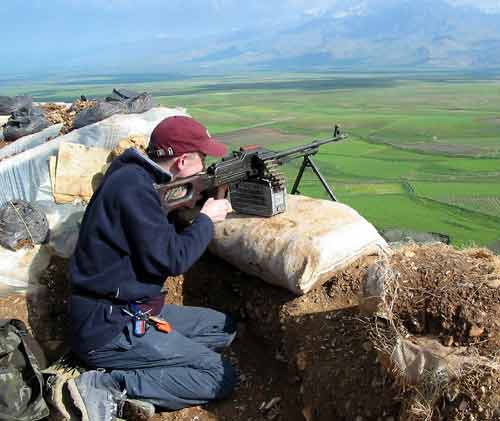
This assignment gets more Apocalypse Now-like by the day. We’re deep down the river and it can only be a matter of time before we come face to face with Colonel Kurtz.
After two days sleeping on the floor in Chamchamal, waiting for bombing raids that never materialised, we moved across to the mountains above Halabja, near the Iranian border, where Peshmerga fighters are battling with Ansar Al-Islam, the “terrorist” group allegedly linked to Al-Qaeda. It was a rather hairy trip. The day before Ansar carried out a suicide bomb attack at a checkpoint, in which an Australian cameraman was killed. Not surprisingly, most journalists moved away from Halabja after that. The hotel is very sombre and there are remembrance pictures of the dead guy pinned up in the lobby. Jim, though, has impeccable military contacts and arranged for an armed escort to take us in.
The Americans have begun bombing raids against Ansar positions in attempt to wipe out the group and we wanted to be there when they happened. At 2am we drove way up into the mountains overlooking Ansar territory and bedded down with the Peshmerga in one of their guard houses. We were woken at 4am by US planes coming over then the sky lit up with orange flashes as they dropped their payloads. The noise was deafening.
Unlike the night before, when the Americans dropped about a hundred missiles, the night we were there they only dropped a handful in quick succession. By the time we realised the raid had begun it was all over. To get the best vantage point we drove right to the top of the mountain – the Peshmerga front line. It was dark, unspeakably bleak and incredibly cold. The Peshmergas took us into their shelter and made us all hot, sweet tea.
I must have dozed off because by the time I came round it was light. As the sun rose, the mountains came to life and we all began to thaw out. The scene was just unreal.
The Peshmergas live in virtually medieval conditions – like St Kilda 200 years ago. They spend weeks or even months in huts and bunkers on the hilltops with no electricity, no hot water, nothing. Just cold water in a tank and a single kerosene stove. Their resilience is unbelievable, their belief in their cause unshakable. The hardships of their lives are plain to see – soldiers in their early 30s look 20 years older.
Here’s a selection of photos taken up there:
Two Peshmerga
Down The Barrel Of A Gun
Poised Peshmerga
Peshmerga With Radio
Peshmerga Smoking
One thing that always strikes me about the Peshmerga is their footwear. They’re all armed to the hilt, pledging to die for the liberation of Kurdistan, and yet they’re wearing trainers, hush puppies and dress shoes. One soldier, with a thick band of ammunition slung around his waist, was wearing a pair of pink sneakers with “My Little Pony” written on them.
Ansar sent a few mortars over as we did a succession of lives on the videophone – without doubt the most remote place I’ve ever done a broadcast from. The generator has earned its keep already.
The Peshmergas were – as always – great hosts; curious, polite and welcoming. Several of them spoke warmly about Tony Blair, asking us to thank him for taking a firm stand against Saddam Hussein. After posing for a group photo I gave them cigarettes and BBC stickers before heading back down the mountain, wondering what would become of them.

0 Comments:
Post a Comment
<< Home